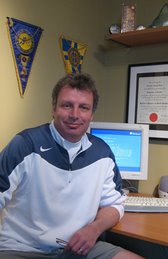12 Mar 2009Calgary HeraldCHRIS SIMNETT ALBERTA HEALTH SERVICES
Penning the Pain Diaries
Deborah Nicholson has published five mystery novels and has three more manuscripts in various stages of the publishing process.
Courtesy, Alberta Health Services
Author Deborah Nicholson, left, is a transcriptionist at the Calgary Health Region’s Chronic Pain Centre. She is with co-worker Dr. Chris Spanswick.
The author of the Kate Carpenter mystery series, which is published by Severn House in England, found the transition from novelist to playwright anything but painful; despite the fact the subject of the play is pain.
The Pain Diaries is the story of Isabelle, a 30something woman who is dealing with chronic pain. It is anticipated to premiere in Calgary in the spring of 2009.
The play is the brainchild of Nicholson, who works as a transcriptionist at the Calgary Health Region’s Chronic Pain Centre.
She came up with the idea after participating in a number of focus group sessions with patients during the accreditation process for the centre about two years ago.
As a transcriptionist, Nicholson gets the cold, hard facts of a patient’s story and spends her days typing them out. She says many of the stories, told like country-and-western songs where the person’s truck broke down, their spouse left, the dog was run over and the house burned down. She had little understanding of these patient’s catastrophic lives and thought they just didn’t know how to deal with things very well.”
But when Nicholson met some patients, their stories — heard face-to-face — made a dramatic impact on the novelist.
“I’ve learned two things while writing this play,” says Nicholson. “I’ve learned reality just is. Your reality for you is as real, as painful and as serious as my reality is to me. Even if your reality is you’re a triple amputee from the Iran war with damaged lungs from the chemicals they were using and my reality is I’ve just had a wart burned off my foot. You’d think those aren’t comparable but in your reality that is the worst that can happen to you and in my reality that is the worst that can happen to me.
“Along with learning what is real to a person comes not being judgmental about them,” she says. “You can’t call them whiners because they’re not whiners. To them, it’s the worst that can happen to them.”
One story in particular hit Nicholson hard. A woman in her mid-30s came to the centre after years of dealing with crippling chronic pain. She thought the centre was her Mecca — the place where she would be cured and all her problems would be taken care of.
The patient met with Dr. Chris Spanswick, Medical Leader of the Regional Pain Program and Pain Physician at the Chronic Pain Centre, for a three-hour assessment.
“One of the things that is always made very clear to the patients is their pain won’t be eradicated, but it may be able to be reduced by about 30 per cent and then they will be shown ways to manage their pain and get their lives back,” says Nicholson. “This woman said she walked in and was expecting this miracle and all she heard was they couldn’t cure her pain. She went home that night and it was the deepest, darkest pit-of-the-soul moment and she seriously thought about killing herself.
“She fell on the floor in the kitchen crying and trying to figure out how she could end it all. She said she woke up the next morning and she remembered the second part of Dr. Spanswick’s sentence ‘we can help you get your life back.’ It was the first time she had any real hope in her entire pain journey.”
Nicholson’s eyes well up as she tells the story.
“Imagine if you couldn’t be intimate with your spouse or play with your kids; you couldn’t pick them up or go out and kick a soccer ball,” says Nicholson. “You have to sit and watch your life pass by.”
In the play, Isabelle is that person. Her pain keeps her confined in a room where she can only look out of a window to glimpse life going on outside.
It’s a powerful image that got into Nicholson’s head and wouldn’t go away. Normally, she would try and find a way to turn the story into a novel, but this one screamed out for the stage.
“It popped into my head,” says Nicholson of Issy’s story. “I did the focus groups and the story that woman told and a few others never left my mind for months.
“One day I was sitting at my desk typing and I had this vision of that woman having this crisis, going home and thinking how she was going to kill herself — searching in drawers for knives and things like that — and then falling on the floor crying because she couldn’t find anything to end it with. Then the house goes black and the show goes into intermission.
“In my mind that’s how I saw it and I knew it had to be a play, it couldn’t be anything else because it was so visual.”
Nicholson, who worked as house manager for Theatre Calgary before joining the health region, says her initial goal in writing the play was to reach out to chronic pain sufferers and let them know there is hope to get their lives back.
“The other purpose is for people like me to learn what I’ve learned; to learn the whole judgment and reality lesson,” she says.
“It’s not just about pain. It’s been a huge epiphany in my life about people and their opinions. If my friend thinks her high school experience was horrible, it was. I can’t argue with her. That is her reality. That has been huge in my life. It’s totally changed my perception and understanding of people.”
Spanswick is enthusiastically behind the project.
He and other staff at the Chronic Pain Centre have been reading the play as it’s written, giving Nicholson feedback to make the work as accurate and powerful as possible.
“I think this is quite an important thing,” he says. “I see the opportunity of this play to not only raise the profile of pain but also to legitimize it to some people. This has a huge potential to educate people.
“What I like about it is it’s innovative; nobody has ever thought about doing it this way. It’s a way of getting across information and understanding in a non-threatening way and a way I think is more likely to stick.”
Nicholson’s script is as funny as it is serious. She’s out to entertain, not preach. She is hoping to hold a gala opening for the play in the spring and run it for at least a week in a prominent Calgary theatre. There is already interest to stage the play in Edmonton and in Australia, where her books are very popular.
I'm hoping this link will take you there.
Saturday, March 28, 2009
Welcome to our new Master of Ceremonies

Welcome to Marlene Robertson, our new Master of Ceremonies around here. She has graciously volunteered to keep this blog running regularly, to free me up to write the play, edit the play, fundraise for the play and eventually stage the play. So you can now watch for regular updates - two to three times a week.
We appreciate all your comments, so please keep them coming.
Here's Marlene's first message.
*************************************************************************************
“You’re such a pain in the neck; Harry is a total pain in the butt.” How many times have we all made these statements and probably many more variations? These are relatively painless pains, and quickly pass. Nothing life-threatening here. But what happens when the pain doesn’t go away? What happens when we live with pain every day, sometimes for weeks, months or years? What happens if the pain never goes away? Well I suspect some of the people we have called a pain in the neck or a pain in the butt live with pain every single day of their lives, but we can’t conceive of that so we think they should just get on with life or suck it up or just grit their teeth and quit complaining. Ah, if only it was that easy. Wouldn’t life be grand?
I’m Deborah’s mom, Marlene, and I'm going to take over as "blog master" here, as the Pain Diaries becomes a reality. Over the years I’ve had some pain: a broken wrist, surgery, root canal and many years of migraine headaches, but until I was in a very bad car accident, I truly had no idea what pain was all about. Lots of bumps and bruises and stitches and six broken vertebra in my neck and back. Paralyzing, numbing, never-ending scary pain. But I am among the blessed because almost eight months after the accident, all six vertebrae have now healed, the pain is pretty much gone and my neck is slowly starting to work again.
What would I have done if I had to live with that pain every day for the rest of my life? Could I have sucked it up, got on with my life or grit my teeth? I don’t know and thank God and my Angels I don’t have to find out, but it made me understand that pain can be overwhelming and can literally cripple you. No more skiing, long walks on a perfect summer evening, or taking your kids camping. No more driving the car, making love with a man you adore, a man who has stuck with you through thick and through thin, a man who is suffering as well. Life will never be the same, and as I was so fond of saying throughout my recovery, “I just want my life back.” I have so very much to be thankful for and never again will I judge anyone who is in pain. Never.
Subscribe to:
Posts (Atom)






